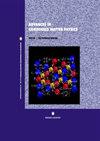First-Principles Study of Structure, Elastic Properties, and Thermal Conductivity of Monolayer Calcium Hydrobromide
IF 1.8
4区 物理与天体物理
Q3 PHYSICS, CONDENSED MATTER
引用次数: 1
Abstract
In recent years, some laboratories have been able to prepare calcium hydrobromide (CaHBr) by melting hydride and anhydrous bromide or metal and bromide in a hydrogen atmosphere at 900°C and have studied some of its properties. But there are few theoretical studies, especially the theoretical studies of monolayer CaHBr. We use the first-principles method to calculate the structure, elastic properties, and lattice thermal conductivity of the monolayer CaHBr based on the Boltzmann transport equation. We obtain a stable crystal structure by the optimization of monolayer CaHBr. By calculating the elastic constant of monolayer CaHBr, its mechanical stability is proved, and the elastic limit of monolayer CaHBr is obtained by biaxial tensile strain on monolayer CaHBr. And the corresponding phonon spectra show no imaginary frequency, indicating the dynamic stability of the monolayer CaHBr. By the ShengBTE code, we calculate the lattice thermal conductivity of the monolayer CaHBr, the iterative solution of BTE and RTA at 300 K–1200 K is obtained, and the lattice thermal conductivity at room temperature is κBTE ι � 2.469W/m · K and κRTA ι � 2.201W/m · K, respectively. It can be seen that the lattice thermal conductivity of monolayer CaHBr is low. And by analyzing the phonon spectrum, the scattering rate, and the mean free path of the phonons, the lattice thermal conductivity of monolayer CaHBrmainly depends on the acoustic modes.We hope this study can provide theoretical guidance for the experiments and practical application of monolayer CaHBr.单层氢溴化钙的结构、弹性和导热性的第一性原理研究
近年来,一些实验室已经能够在900℃的氢气气氛中,将氢化物和无水溴化物或金属和溴化物熔化,制备氢溴化钙(CaHBr),并对其一些性质进行了研究。但理论研究很少,尤其是单层CaHBr的理论研究。基于玻尔兹曼输运方程,利用第一性原理方法计算了单层CaHBr的结构、弹性性能和晶格导热系数。通过对单层CaHBr的优化,获得了稳定的晶体结构。通过计算单层CaHBr的弹性常数,证明了其力学稳定性,并通过对单层CaHBr的双轴拉伸应变得到了单层CaHBr的弹性极限。相应的声子谱没有虚频率,表明单层CaHBr具有动态稳定性。利用ShengBTE代码,计算了单层CaHBr的晶格导热系数,得到了300 K - 1200 K下BTE和RTA的迭代解,得到了室温下的晶格导热系数分别为κBTE ι ι 2.469W/m·K和κRTA ι ι 2.201W/m·K。可以看出,单层CaHBr的晶格导热系数较低。通过对声子谱、散射率和声子平均自由程的分析,发现单层cahbr的晶格热导率主要取决于声模。希望本研究能为单层CaHBr的实验和实际应用提供理论指导。
本文章由计算机程序翻译,如有差异,请以英文原文为准。
求助全文
约1分钟内获得全文
求助全文
来源期刊

Advances in Condensed Matter Physics
PHYSICS, CONDENSED MATTER-
CiteScore
2.30
自引率
0.00%
发文量
33
审稿时长
6-12 weeks
期刊介绍:
Advances in Condensed Matter Physics publishes articles on the experimental and theoretical study of the physics of materials in solid, liquid, amorphous, and exotic states. Papers consider the quantum, classical, and statistical mechanics of materials; their structure, dynamics, and phase transitions; and their magnetic, electronic, thermal, and optical properties.
Submission of original research, and focused review articles, is welcomed from researchers from across the entire condensed matter physics community.
 求助内容:
求助内容: 应助结果提醒方式:
应助结果提醒方式:


